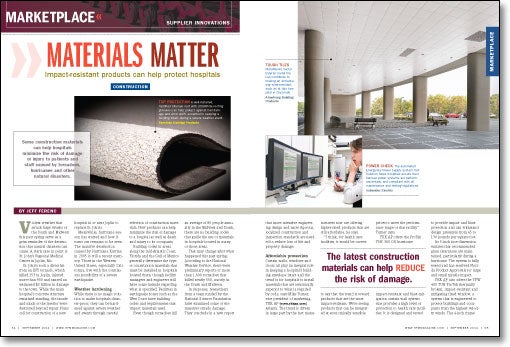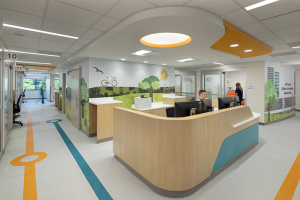Materials matter

Some construction materials can help hospitals minimize the risk of damage or injury to patients and staff caused by tornadoes, hurricanes and other natural disasters.
Violent weather that struck large swaths of the South and Midwest this past spring serve as a grim reminder of the destruction that natural disasters can cause. A stark case in point is St. John's Regional Medical Center in Joplin, Mo.
St. John's took a direct hit from an EF5 tornado, which killed 153 in Joplin, injured more than 900 and caused an estimated $3 billion in damage to the town. While the main hospital's concrete structure remained standing, the facade and much of the interior were destroyed beyond repair. Plans call for construction of a new hospital in or near Joplin to replace St. John's.
Meanwhile, hurricane season has started and how it turns out remains to be seen. The massive destruction caused by Hurricane Katrina in 2005 is still a recent memory. Those in the Western United States, especially California, live with the continuous possibility of a severe earthquake.
Weather hardening
While there is no magic solution to make hospitals disaster-proof, they can be hardened against severe weather and events through careful selection of construction materials. New products can help minimize the risk of damage to a hospital as well as death and injury to its occupants.
Building codes in areas along the mid-Atlantic Coast, Florida and the Gulf of Mexico generally determine the type of construction materials that must be installed in hospitals located there, though facility managers and engineers still have some latitude regarding what is specified. Facilities in earthquake zones such as the West Coast have building codes and requirements that impact materials used.
Even though tornadoes kill an average of 80 people annually in the Midwest and South, there are no building codes that guide the use of materials in hospitals located in many of those areas.
That may change after what happened this past spring. According to the National Weather Service, there were preliminary reports of more than 1,600 tornadoes that killed nearly 550, mostly in the South and Midwest.
In response, researchers from a team funded by the National Science Foundation have examined some of the massive tornado damage. They conclude in a new report that more intensive engineering design and more rigorous, localized construction and inspection standards are needed to reduce loss of life and property damage.
Affordable protection
Curtain walls, windows and doors all play an integral role in keeping a hospital's building envelope intact and the trend is for hospitals to install materials that are structurally superior to what is required by code, says Mike Turner, vice president of marketing, YKK AP (www.ykkap.com), Atlanta. The trend is driven in large part by the fact manufacturers now are offering higher-rated products that are still affordable, he says.
"I think, for health care facilities, it would be correct to say that the trend is toward products that are the most impact-resistant. We're seeing products that can be integrated at economically sensible prices to meet the performance range of that facility," Turner says.
YKK AP offers the ProTek YHC 300 OG hurricane impact-resistant and blast-mitigation curtain wall system that provides a high level of protection to health care facilities. It is designed and tested to provide impact and blast protection and can withstand design pressures from 45 to 130 pounds per square foot.
Its 3-inch face dimension ensures that recommended glass clearances are maintained, particularly during a hurricane. The system is fully tested and has received Florida Product Approvals for large and small missile impact.
YKK AP also offers the YFW 400 TUH ProTek thermally broken, impact-resistant and mitigating fixed window, a system that is engineered to protect buildings and occupants from the highest velocity winds. The 4-inch frame depth provides strong protection, as well as superior air and water performance.
Wausau (Wis.) Window and Wall Systems (www.wausauwindow.com) is another leading manufacturer of curtain walls and windows that are engineered to meet impact-resistant building codes. The company's 3250-HP Hurricane Series windows provide impact-tested protection for health care facilities and their occupants.
Wausau's 7250i-UW Thermal Unit Wall series is engineered to meet most span and wind-load building requirements. It features an interlocking frame design to accommodate seismic, live load and thermal building movements and is approved by California's Office of Statewide Health Planning and Development to meet state hospital seismic requirements.
Tested-tough doors
Doors that will withstand the punishment delivered by hurricanes and tornadoes are essential to maintaining a hospital's building envelope throughout a severe weather event, says Matt Guise, category leader for doors, frames and accessories for Steelcraft, Ives and Glynn-Johnson, divisions of Ingersoll Rand Security Technologies (http://w3.securitytechnologies.com), Carmel, Ind.
"The door can't open, it has to remain closed. Under pressure the door can't leave the confines of the frame so that as pressure is building up, it doesn't pry itself far enough apart so that you've exposed people or assets inside the building to all of the weather," Guise says.
To qualify as impact-resistant, a two-by-four test projectile can't penetrate the door, plus any hardware on the door has to remain latched and intact. "So if a two-by-four hits the door and the latch bolt of the lock disintegrates and the door just flops, then you have a failure of the opening as well," he explains. "Your opening is only as good as the weakest link. It's critical that it is looked at more as an assembly than as a system of components."
Steelcraft has two doors specifically designed for severe weather applications. The H-Series is Steelcraft's hurricane-resistant door. It is designed to withstand sustained winds and heavy impact from debris. It's built with A60 galvanized steel for superior corrosion resistance in the coastal climates that are subject to hurricanes.
For tornado impact-resistance, Steelcraft manufactures the Paladin Series. Paladin doors are built to stand up to short periods of extremely high wind force and debris, meeting Federal Emergency Management Agency (FEMA) 361 and 320 compliance for community safe rooms.
Ingersoll Rand also offers the Schlage LM9000 Multipoint Solution, which is an integrated door, lock and vertical rod system. It provides three points of protection to maintain both the integrity of the opening and the safety of the tenants inside during extreme conditions. The product is tested to meet FEMA 361 and 320 standards.
Keeping a roof intact during severe weather is critical and the installation is every bit as important as the material, says Phil LaDuke, director of quality assurance, Firestone Building Products (www.firestonebpco.com), Indianapolis. "When you're talking about a roof coming off in a hurricane or high wind, you want to make sure that the perimeter is attached very well. Your first line of defense is at that perimeter," he says.
LaDuke says the trend for hospitals is to install concrete decks topped by modified bitumen roofs, which consist of a reinforced sheet with asphalt on both sides and granules on the top side. "The advantage of that system with a concrete deck is you get some very high wind uplift resistance," he says.
Firestone offers the UltraWhite Modified Bitumen Cap Sheet, a highly reflective granule-surfaced roofing solution that provides enhanced light reflectivity and heat emissivity. UltraWhite meets requirements for California's Title 24 energy-efficiency standards and can help achieve points in the U.S. Green Building Council's Leadership in Energy and Environmental Design rating system.
Available in styrene-butadiene-styrene rubber modified asphalt and atactic polypropylene, UltraWhite can be applied with hot asphalt, torch or cold adhesive and is compatible with steel, concrete, plywood and wood decks, providing great versatility and appeal. The product can be used for both new and reroof applications.
Paul A. Hough, manager, product fire and seismic performance, Armstrong Building Products (www.armstrong.com), Lancaster, Pa., says the general emphasis in hospitals is to keep the exterior as resilient as possible so it remains operational after a high-wind disaster. He sees the same trend in severe seismic zones such as California.
The company offers Armstrong MetalWorks Vector and Vector Exterior metal ceiling tiles that can be installed outside at entranceways and other locations at a hospital. The panels are 100 percent downward-accessible without tools and are made of highly durable, powder-coated steel that is washable and impact- and soil-resistant. An exterior system is available and tested to meet wind uplift Classes 30, 60 and 90.
Extra protection
Moving beyond construction materials, automated reporting products quickly can provide facility managers and engineers with critical information about either a specific system or the overall condition of a building or campus.
Keith Stager, U.S. health care market segment manager, Schneider Electric (www.schneider-electric.com), Palatine, Ill., says his company's automated Square D PowerLogic emergency power supply system test solution helps hospitals ensure their backup power systems are always ready to perform and are compliant with all maintenance and testing regulations.
The system automates and streamlines test procedures while electronically documenting a wide range of test measurement data points, making it easy to report on emergency power system status as needed. It helps to ensure a facility's emergency power supply system complies with regulatory or policy requirements. It also informs staff about energy-saving opportunities.
Reflexx Smart System for Buildings from Digitexx Data Systems (www.digitexx.com), Scottsdale, Ariz., is a new damage detection and performance evaluation reporting system that provides essential structural data in less than 15 minutes.
When an event occurs and sensor thresholds are exceeded, Reflexx generates detailed analyses and damage localization reporting for the facility manager and engineer based on the building's performance before, during and after the event. Reflexx provides global, floor-by-floor and component-level damage assessment based on building parameters such as accelerations, displacements, velocities, interstory drift ratios and shears.
Measuring the structural integrity of a building following an earthquake or other natural disaster allows facility managers to more quickly determine if a building is safe or must be evacuated, or if it is safe for occupants to re-enter.
Farzad Naeim, past president of Earthquake Engineering Research Institute, current president of L.A. Tall Buildings Council and director of research at John A. Martin and Associates, developed the system with Digitexx. He says getting a quick analysis of a building's structural status eliminates the need to wait days or weeks for outside officials to evaluate a building.
"Even if you have an engineer in place before an extreme event happens, it may only reduce the wait time for a visual inspection and assessment from weeks to days," he says. "But many buildings need to make decisions within minutes."
Jeff Ferenc is senior editor of Health Facilities Management.
| Sidebar - For more information |
|
For further details on the building products featured in this month's "Marketplace" article, readers can contact the following vendors: Armstrong Building Products
Digitexx Data Systems
Firestone Building Products Ingersoll Rand Security Technologies Schneider Electric Wausau Window and Wall Systems YKK AP
|




